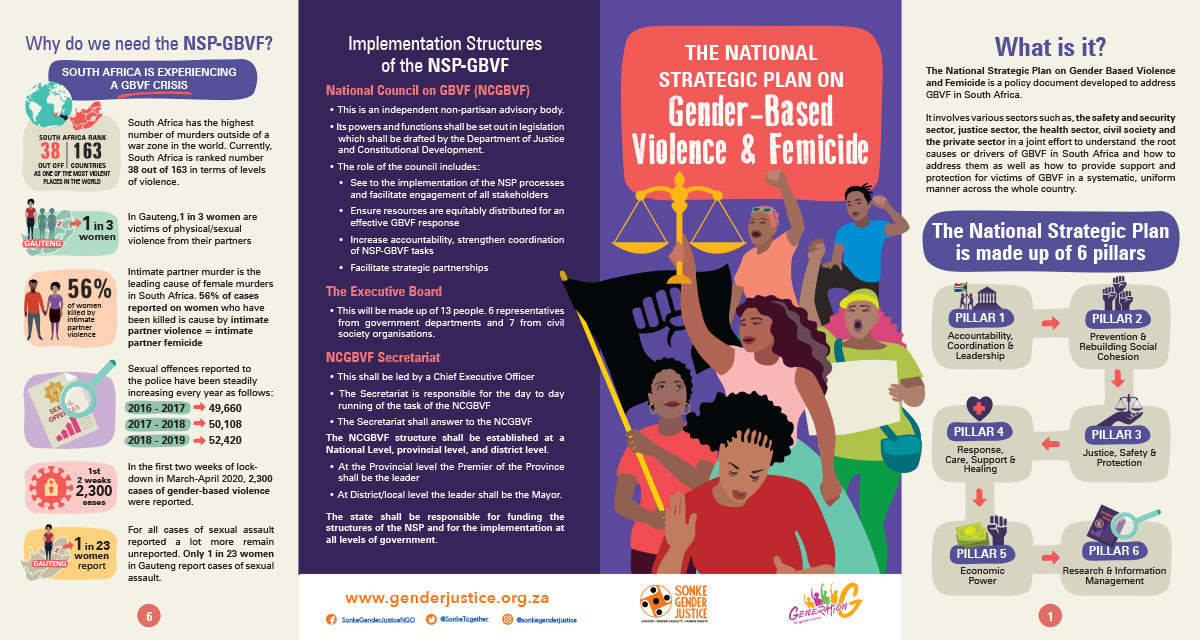- 021 423 7088
- info@genderjustice.org.za
- Whistleblower: 0800 333 059

Right now, our country is experiencing a Gender-Based Violence and Femicide crisis (when a woman is murdered, it is called ‘femicide’).
Because of this, in 2020, the South African government created a National Strategic Plan on Gender-Based Violence and Femicide (NSP-GBVF). This plans how the government – and South Africa, as a country – can improve the way it prevents and deals with gender-based violence and femicide.
Now we have this plan in place, it’s time to make sure the South African government does what it has planned to do!
Do you want to take action, as a young person? Do you want to hold our government accountable, and help stop GBVF in South Africa?
You can start by getting to know the NSP-GBVF today!

This pillar makes sure government departments work together to prevent gender-based violence and femicide.
This pillar asks, ‘who is responsible?’ We are all accountable for addressing gender-based violence, and we must hold one another accountable - from the president to you and your neighbour. This pillar outlines how:
This pillar makes sure we address the root causes of gender-based violence and femicide in our country.
This pillar asks, ‘why do we have a gender-based violence and femicide crisis in South Africa?’ It works out how to deal with these root causes by rebuilding the society in which we live.
This pillar finds solutions to the current failures in the legal system around gender-based violence and femicide.
This pillar asks, ‘why is the legal system failing with some cases of gender-based violence and femicide - and how can we improve this?’
All survivors of gender-based violence should be able to access efficient and sensitive criminal justice, quickly and efficiently. Some of the solutions that the National Strategic Plan suggests are:
This pillar is about creating systems of support for survivors of gender-based violence.
This pillar asks, ‘how can we make sure that survivors of gender-based violence can access supportive, healing processes that allow them to reclaim their lives?’
This is done by making sure that different government institutions and civil society organisations work together to give support to survivors of GBV. For example, when a health facility helps a victim of GBV after the case has been reported to the police.
This pillar outlines how we must ensure that:
This pillar also speaks about the importance of communities and neighbourhoods, and how they can provide support for GBV survivors. This means developing safe spaces in the community for survivors to come together to express themselves without fear or shame. Communities can do this through establishing informal platforms such as
This pillar is about improving women’s opportunities to find work and be financially independent.
This pillar asks, ‘how can we create ways for women to be more financially independent?’
Often, women stay in abusive relationships because they are financially dependent on their abuser. This means they are not only physically abused; they are also economically abused.
This pillar aims to address this by;
This pillar makes sure that proper research on gender-based violence takes place so that we better understand, and deal with, GBV.
This pillar asks, ‘how can we make sure that we bring together different knowledge about gender-based violence to make a real difference?’
Making sure that research on GBV is coordinated and shared by different stakeholders is important. This pillar aims to make sure that:

You will need to provide your email address or phone number, so that we can contact the winners. Your information will not be shared.
Fill out the questions below to automatically enter the draw:


Sonke is a South African-based non-profit organisation working throughout Africa. We believe women and men, girls and boys can work together to resist patriarchy, advocate for gender justice and achieve gender transformation.
Please note that Sonke does not offer counselling or other support services to individuals. Click here for information on where to get help.
Sign up for the Sonke e-Newsletter to receive social justice news and views in your inbox.
Please see our Privacy Policy here.